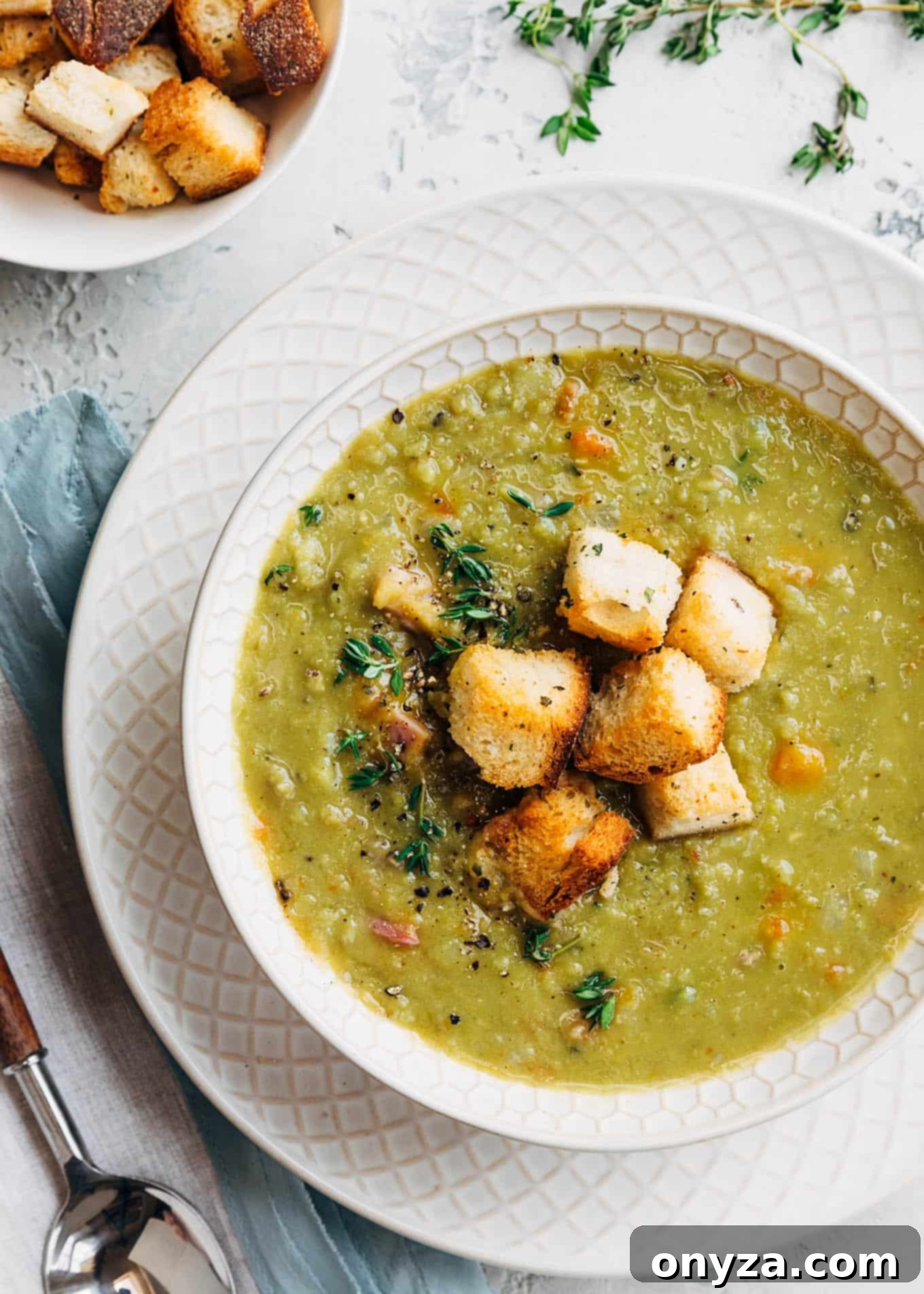Split Pea Soup with Ham is a timeless classic, a truly heartwarming and comforting dish that perfectly encapsulates the essence of home cooking. This rich, smoky, and utterly satisfying soup is particularly ideal for transforming leftover ham (and that precious ham bone) from a festive holiday dinner into another spectacular meal. But what if you don’t have a ham bone readily available? No need to worry! Our comprehensive guide includes simple substitutions to ensure everyone can enjoy a bowl of this delicious, nourishing soup.
The Enduring Appeal of Homemade Split Pea Soup with Ham
There’s something uniquely satisfying about creating a delicious new meal from holiday leftovers. For many, including our family, preparing a hearty batch of Split Pea Soup is a cherished tradition, especially when a ham bone is waiting in the fridge. This usually follows a festive occasion like Christmas or Easter, where a succulent Honey Mustard Glazed Ham has graced our table.
Our family’s cherished recipe for Split Pea Soup is simmered slowly with a blend of aromatic vegetables and herbs until it achieves a wonderfully thick and hearty consistency. Each spoonful delivers a comforting embrace, subtly smoky from the ham, a touch sweet from the carrots, and profoundly satisfying. It’s more than just a meal; it’s a bowlful of warmth and nostalgia.
Looking for more creative ways to use leftover ham? Be sure to explore our recipes for decadent Monte Cristo Sandwiches and our crowd-pleasing Ham and Cheese Puff Pastry Slab Pie!

What Exactly Are Split Peas?
Split peas are a cornerstone ingredient in many comforting soups and stews around the world. These legumes are simply field peas that have been dried, peeled, and then split in half. This splitting process makes them cook much faster than whole dried peas, as it exposes more surface area to the cooking liquid.
You’ll typically find two main varieties: yellow and green. Yellow split peas generally offer a milder, earthier flavor, often favored in Indian dals and some curries. Green split peas, on the other hand, tend to be sweeter and maintain a slightly more vibrant color when cooked, making them a popular choice for classic split pea soup.
Nutritional Powerhouse and Easy Preparation
Beyond their delicious flavor, split peas are a nutritional powerhouse. They are remarkably low in fat, yet generously packed with dietary fiber and plant-based protein, making them an excellent choice for a healthy and filling meal. Furthermore, they are a good source of essential vitamins and minerals, including Vitamins A, B, and magnesium.
One of the best advantages of cooking with split peas is their convenience: unlike many other dried legumes, they do not require pre-soaking. A simple rinse and quick sort to remove any potential debris or small stones is all that’s needed before they hit the pot. As they simmer in a flavorful stock, split peas naturally break down, thickening the soup into a creamy, textured purée without the need for an immersion blender or any extra fuss.
Crafting the Perfect Split Pea Soup with Ham: A Step-by-Step Guide
Since split peas possess a naturally mild flavor, building a robust and balanced taste profile is crucial for a truly outstanding soup. While the ham provides a significant boost of savory depth and smoky notes, a carefully constructed base of aromatic vegetables, fresh herbs, and a well-flavored stock are equally vital.
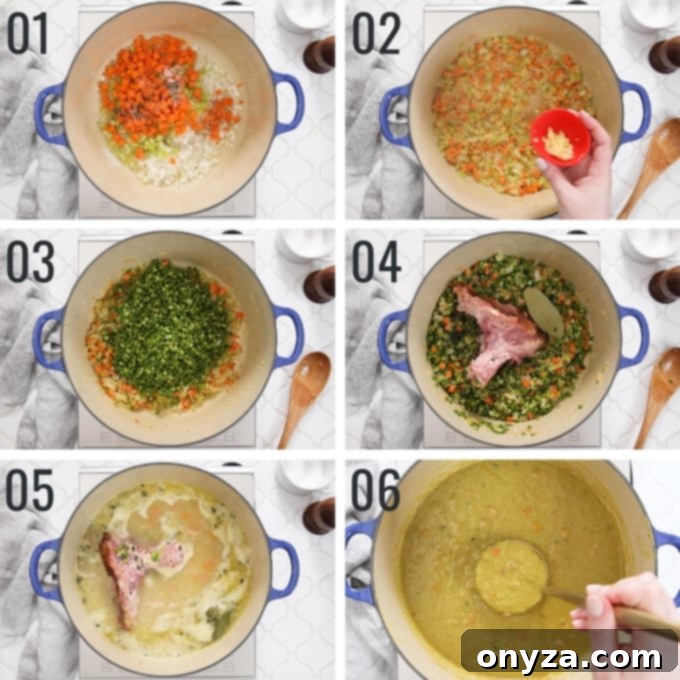
Building the Flavor Foundation
We begin this journey to flavor with a classic mirepoix – a foundational blend of finely diced onions, carrots, and celery – gently softened in a generous knob of butter. This step is essential as it coaxes out the natural sweetness and aromatic qualities of the vegetables. For an added layer of piquant flavor, our family often incorporates a couple of minced garlic cloves into this initial sauté. (This stage is beautifully captured in the first two process photos).
Once your vegetables are tender and fragrant, creating an inviting aroma that fills your kitchen, it’s time to introduce the heart of the soup. Add the rinsed split peas, the star ham bone, a dried bay leaf, and fresh thyme directly into the pot. This recipe prides itself on its simplicity – just combine all these wonderful ingredients and give them a good stir! (As demonstrated in process photos 03 and 04).
Chef’s Tip for Seasoning: The saltiness of ham can vary significantly based on the brand and how it was prepared. To ensure your soup is perfectly seasoned, it’s wise to start with a minimal amount of salt and then adjust to taste once the soup has finished simmering. This allows you to achieve the ideal flavor balance without over-salting.
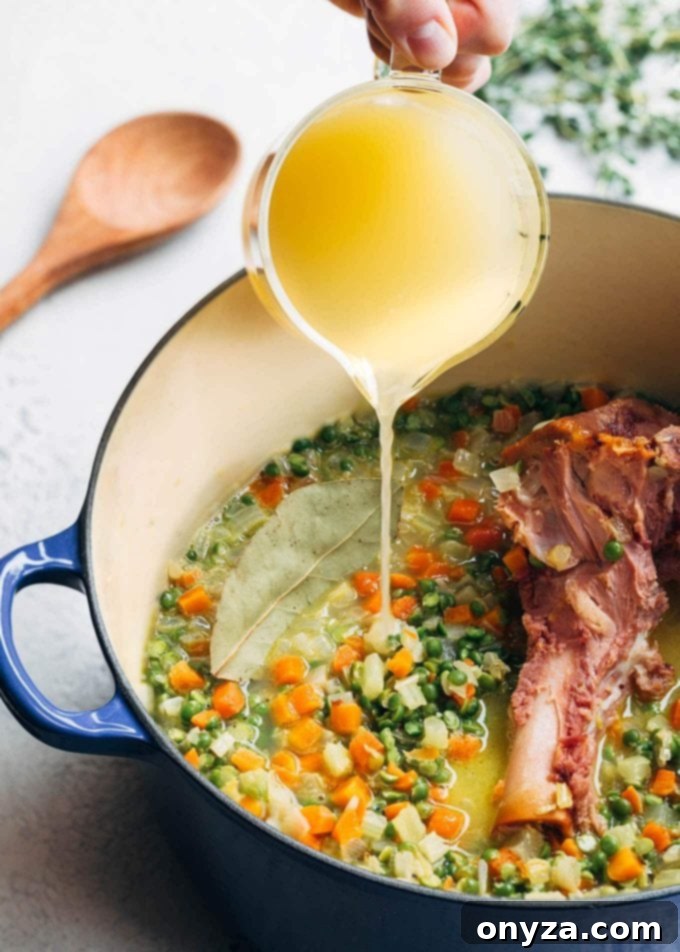
The Gentle Art of Simmering
For the cooking liquid, we recommend a thoughtful blend of chicken stock and water. This combination is key to ensuring the soup develops a rich, savory depth without becoming overly “chicken-y.” However, if you prefer, using all chicken stock is also perfectly acceptable and will result in a more intense flavor profile. This flexibility allows you to customize the soup to your personal taste.
The split peas will gently simmer and break down over approximately 60-90 minutes. As they cook, they release their starches, naturally thickening the soup into a beautifully textured purée. We find this natural consistency to be perfect, eliminating the need for further blending. (Observe the peas transforming in process photo 05). Throughout this simmering period, remember to stir occasionally, especially as the soup begins to thicken, to prevent any sticking to the bottom of the pot.
To add a delightful textural contrast and ensure the ham remains tender and flavorful, we incorporate diced ham during the final 15 minutes of cooking. Adding it just before serving allows it to warm through thoroughly without releasing excessive additional salt into the soup, preserving the delicate balance of flavors.
Once the split peas have fully cooked and achieved that wonderful, creamy texture, you can fine-tune the soup’s thickness to your exact preference. If you find the soup too thick, simply stir in a bit more chicken stock or water until it reaches your desired consistency. For those who enjoy a particularly robust and thick soup, simply allow it to simmer for a few extra minutes. It’s important to remember that the soup will continue to thicken as it cools and stands, so factor this into your adjustments.
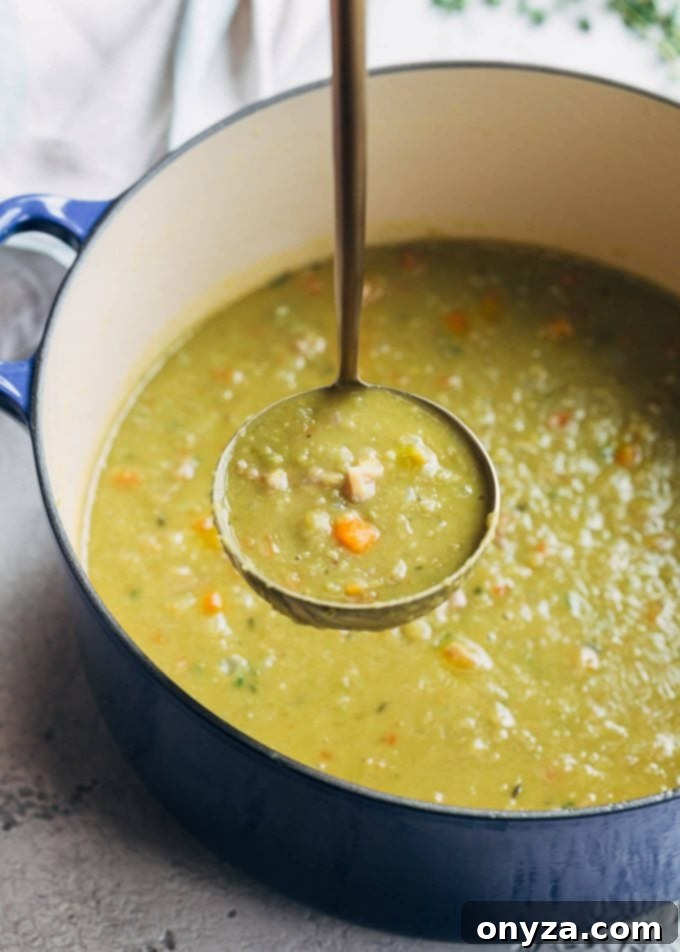
Serving Suggestions: The Perfect Accompaniments
While Split Pea Soup with Ham is undoubtedly a filling meal on its own, a few thoughtful additions can elevate the dining experience. Our family’s favorite accompaniment is a generous topping of crispy Buttery Garlic Croutons. The delightful crunch of the croutons provides a wonderful textural contrast to the creamy, smooth soup and infuses each bite with an extra burst of savory garlic flavor.
If croutons aren’t your preference, a thick slice of crusty artisan bread is an equally superb choice for dipping into the rich broth. A final flourish of freshly-cracked black pepper enhances the soup’s inherent flavors, adding a subtle warmth and aroma. Grab a spoon and savor every comforting mouthful!
Consider pairing your soup with a light, crisp green salad for a balanced meal, or even a simple grilled cheese sandwich for an ultimate comfort food duo. The versatility of this soup makes it a perfect main course or a substantial appetizer.
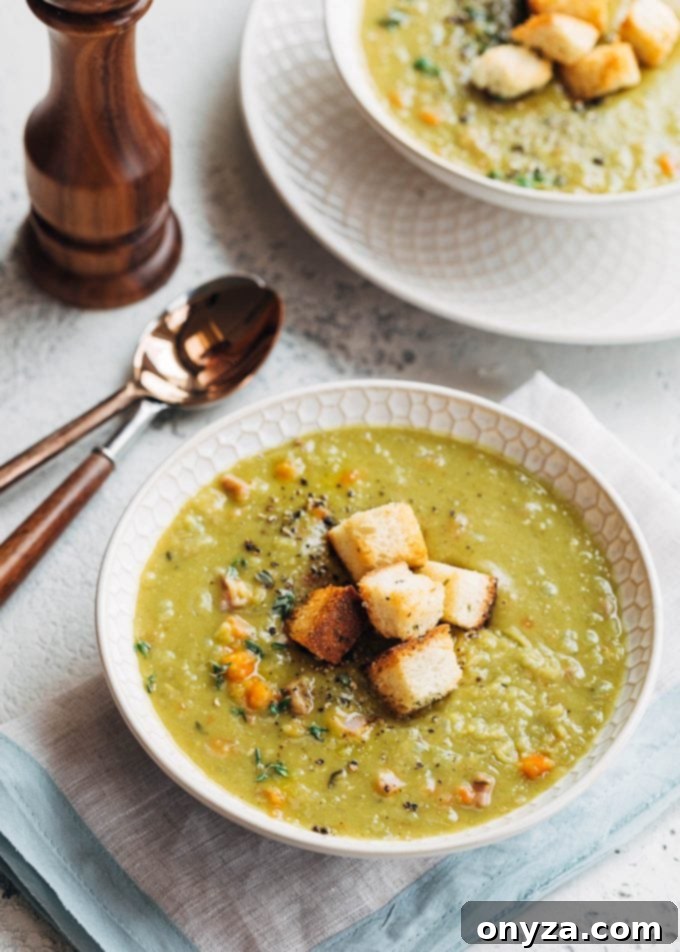
Split Pea Soup FAQ’s: Your Questions Answered
Updated: January 2020. We’ve been absolutely delighted by how many of you have made and cherished our family’s Split Pea Soup recipe! We’ve gathered and answered some of the most common questions that have come up in the comments to help you achieve the best results.
Q. I don’t have a leftover ham bone. What can I substitute?
A. A ham bone is the secret to the rich, smoky depth of this soup, but don’t despair if you don’t have one! You can often purchase meaty ham bones from specialty butchers or even large grocery stores. In many cases, you might find them available from places like The Honey Baked Ham Company; a quick call to your local store might allow them to reserve one for you.
An excellent alternative is to use smoked ham hocks. These flavorful cuts come from the lower part of the pig’s leg, near the ankle, and impart an incredible smoky richness to slow-simmered soups and braises. Typically, two smoked ham hocks (roughly 1.5 pounds total) will work well. Once the soup is cooked, simply remove the ham hocks, pull the tender meat from the bones, shred it, and return it to the pot before serving. Do keep in mind that ham hocks can be saltier than a typical ham bone, so be sure to adjust the amount of added salt in your recipe accordingly.
Q. My peas won’t cook! Did I need to soak them first?
A. Generally, split peas are designed to cook without pre-soaking, unlike many other dried beans. If your split peas remain stubbornly hard after simmering for 90 minutes (or even two hours), several factors might be at play:
- Old Split Peas: Split peas do not have an indefinite shelf life. As they age and become excessively dry, their cooking time can drastically increase. When buying or checking your pantry stock, look for vibrant color. Very pale peas are often older and may take much longer to soften.
- High Altitude Cooking: If you’re cooking at an elevation higher than approximately 2,000 feet above sea level, liquids boil at a lower temperature, which can significantly lengthen cooking times for legumes. For more detailed guidance, consult resources on high altitude cooking from the US Department of Agriculture.
- Acidity in Water: The presence of acid can hinder the softening of legumes during cooking. If you’re using tap water that happens to be acidic, this could be contributing to your peas’ refusal to break down. You could try using filtered water, or a pinch of baking soda (about 1/4 teaspoon for a large pot) can help neutralize acidity and speed up cooking, though it can sometimes affect flavor slightly.
Q. Can I make split pea soup ahead of time? How should I store the leftovers?
A. Absolutely! Split pea soup is an excellent candidate for make-ahead meals and meal prepping. You can prepare this recipe in advance and store it in an airtight container in the refrigerator for up to 3 days. When reheating, you might notice the soup has thickened considerably; simply add a bit of extra chicken stock or water to achieve your desired consistency as it warms. This soup also freezes exceptionally well for 2-3 months. Thaw overnight in the refrigerator before reheating gently on the stovetop, adding liquid as needed.
Q. Can I add diced potatoes to the soup?
A. While our family typically enjoys this recipe without potatoes, they are certainly a delicious addition if you wish to include them! Peel and cut your potatoes into a 1/2-inch dice. Add them to the pot during the last 30 minutes of cooking, allowing them to simmer until they are tender. Keep in mind that the starches from the potatoes can make the soup a bit thicker, so be prepared to add additional stock or water after they’ve softened to reach your preferred soup consistency.
Craving more culinary inspiration? We invite you to join our exclusive Facebook group community, where we share delightful recipes, expert hosting tips, creative party ideas, and much more!
Want a quick visual guide to this recipe? Discover our Split Pea Soup with Ham Web Story!

Split Pea Soup with Ham
Amanda Biddle
15 minutes
1 hour 15 minutes
1 hour 30 minutes
6 servings
Ingredients
- ¼ cup unsalted butter
- 2 cups chopped onion
- 1 cup diced carrot (1/4-inch dice)
- 1 cup diced celery (1/4-inch dice)
- ¼ to 1 teaspoon kosher salt, to taste
- ½ teaspoon freshly-ground black pepper, plus additional to taste
- 2 cloves garlic, minced
- 1 pound dried split peas, rinsed and sorted
- 1 meaty ham bone
- 1 large bay leaf (or 2 small)
- 2 teaspoons fresh thyme leaves, chopped and quantity divided
- 6 cups chicken stock (low sodium)
- 2 cups water
- 1 cup diced ham (1/4-inch dice)
- Buttery Garlic Croutons, for serving
Instructions
In a large pot or Dutch oven, melt butter over medium heat until foaming subsides. Add onion, carrot, celery, ¼ teaspoon salt, and ½ teaspoon pepper. Cook until vegetables are softened, about 5-8 minutes. Add garlic and cook for 1 minute until aromatic. Stir in the rinsed split peas.

Add the ham bone, bay leaf, and 1 teaspoon of fresh thyme. Stir in the chicken stock and water. Bring the mixture to a boil, then reduce the heat to a gentle simmer. Cook uncovered for 60-90 minutes, stirring occasionally, until the split peas are fully cooked down and the soup has thickened to your desired consistency. Stir more frequently as the soup thickens, and add a little additional stock or water if it becomes too thick for your taste.

Add the diced ham during the last 15 minutes of cooking. When ready to serve, carefully remove and discard the ham bone and bay leaf. Stir in the remaining 1 teaspoon of fresh thyme. Taste and season with additional salt, if needed, remembering our tip about ham saltiness. Serve hot, garnished with buttery garlic croutons and a sprinkle of cracked black pepper.

Notes
*Salt content can vary significantly across brands and preparations of ham. This is why we highly recommend seasoning the soup to taste after it’s finished simmering. If you find your ham to be particularly salty even before cooking, you might consider omitting the ¼ teaspoon salt when sweating the vegetables initially.
Ham Bone Substitution:
*If you do not have a leftover ham bone, two smoked ham hocks can be substituted (approximately 1-1/2 pounds total). They are typically saltier than a ham bone, so reduce the amount of added salt in your soup accordingly. When you remove the ham hocks from the pot, shred the tender meat off the bones and return it to the pot before serving. Discard the bones.
Make-Ahead and Storage:
This soup is perfect for preparing in advance. It can be stored, tightly covered, in the refrigerator for up to 3 days, or frozen for 2-3 months. When reheating (to an internal temperature of 160 degrees F), you may need to add additional stock or water to thin the soup to your preferred consistency.
Have a question about this recipe that wasn’t covered? Check out the FAQ’s section above, or feel free to leave a comment below. We’ll do our best to assist you!
Nutrition Estimate (Per Serving)
Calories: 468 kcal | Carbohydrates: 62g | Protein: 29g | Fat: 12g | Saturated Fat: 5g | Cholesterol: 37mg | Sodium: 1025mg | Potassium: 1183mg | Fiber: 21g | Sugar: 13g | Vitamin A: 4030IU | Vitamin C: 8.9mg | Calcium: 84mg | Iron: 4.4mg
Nutrition information is automatically calculated and should only be used as an approximation.
Please note that our recipes have been developed using the US Customary measurement system and have not been tested for high altitude/elevation cooking and baking.
Enjoyed this recipe? Share your experience and leave a comment below!
